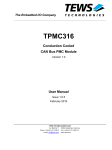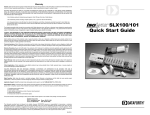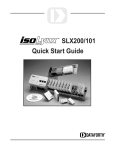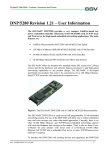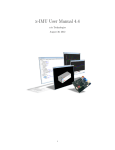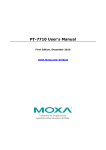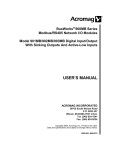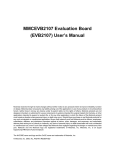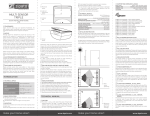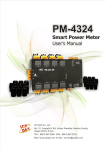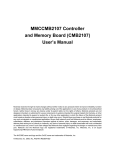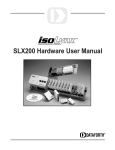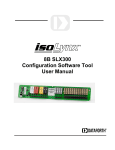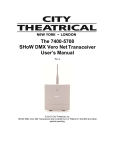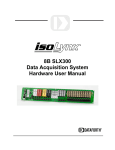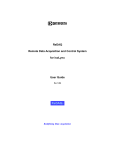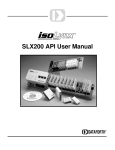Download isoLynx™ SLX200 Software User Manual
Transcript
SLX200 Software User Manual isoLynx™ SLX200 Software User Manual isoLynx™ SLX200 Software User Manual MA1025 Rev. D—November 2006 The information in this manual has been checked carefully and is believed to be accurate; however, Dataforth assumes no responsibility for possible inaccuracies or omissions. Specifications are subject to change without notice. © 2005-2006 Dataforth Corporation. All rights reserved. isoLynx is a trademark of Dataforth Corporation. IBM, IBM PC, XT, AT, and PS/2 are trademarks or registered trademarks of International Business Machine Corporation. Microsoft, MS-DOS, Windows, Windows NT, Visual Studio, Visual C++, and Visual BASIC are trademarks or registered trademarks of Microsoft Corporation. National Instruments™ and LabVIEW™ are trademarks or registered trademarks of National Instruments Corporation. i isoLynx SLX200 Software User Manual ii Table of Contents 1. INTRODUCTION .........................................................................................................................................1 1.1. RELATED DOCUMENTS ............................................................................................... 1 1.2. DOCUMENT CONVENTIONS ......................................................................................... 1 2. DEVICE OPERATION .................................................................................................................................3 2.1. DEVICE CONFIGURATION ............................................................................................ 3 2.2. ANALOG DATA ........................................................................................................... 3 2.2.1. 2.2.2. Reading Analog Data.................................................................................................................4 Writing Analog Data..................................................................................................................5 2.3. DIGITAL DATA ............................................................................................................ 6 2.3.1. 2.3.2. 3. Reading Digital Data .................................................................................................................6 Writing Digital Data ..................................................................................................................6 ISOLYNX SLX200 COMMUNICATION INTERFACE.............................................................................7 3.1. MODBUS PROTOCOL ................................................................................................... 7 3.1.1. 3.1.2. 3.1.3. 3.1.4. 3.1.5. Modbus RTU .............................................................................................................................7 Modbus TCP ..............................................................................................................................7 Modbus Function Codes ............................................................................................................7 Modbus Addresses.....................................................................................................................8 Modbus Exceptions....................................................................................................................8 3.2. CHANGING THE COMMUNICATION PROTOCOL ............................................................ 9 3.3. RESETTING COMMUNICATION PARAMETERS TO FACTORY DEFAULT VALUES ............ 9 3.4. MODBUS RTU PARAMETERS .................................................................................... 10 3.4.1. Modbus RTU Parameter Registers ..........................................................................................11 3.5. MODBUS TCP PARAMETERS ..................................................................................... 12 3.5.1. 4. Modbus TCP Parameter Registers ...........................................................................................13 ANALOG CHANNEL CONFIGURATION...............................................................................................15 4.1. ANALOG CHANNEL STATES ...................................................................................... 16 4.1.1. Analog Channel State Registers...............................................................................................16 4.2. ANALOG CHANNEL AVERAGE WEIGHTS ................................................................... 17 4.2.1. Analog Channel Average Weight Registers ............................................................................17 4.3. ANALOG CHANNEL DEFAULT OUTPUTS.................................................................... 18 4.3.1. 5. Analog Channel Default Output Registers...............................................................................18 DIGITAL CHANNEL CONFIGURATION ...............................................................................................19 5.1. DIGITAL CHANNEL STATES ....................................................................................... 20 5.1.1. Digital Channel State Registers ...............................................................................................20 5.2. DIGITAL OUTPUT DEFAULT OUTPUTS ....................................................................... 21 5.2.1. 6. Digital Channel Default Output Registers ...............................................................................21 DIGITAL PANEL CONFIGURATION......................................................................................................23 6.1. DIGITAL PANEL BYPASS ........................................................................................... 23 6.1.1. 7. Digital Panel Bypass Registers ................................................................................................23 ANALOG SCAN CONFIGURATION .......................................................................................................25 7.1. SCAN MODE .............................................................................................................. 26 7.1.1. Scan Mode Register .................................................................................................................26 7.2. USER-DEFINED SCAN PARAMETERS ......................................................................... 27 7.2.1. User-Defined Scan Parameter Registers ..................................................................................27 iii isoLynx SLX200 Software User Manual 8. READING ANALOG DATA..................................................................................................................... 29 8.1. CONTINUOUS SCAN DATA ........................................................................................ 29 8.1.1. Continuous Scan Data Registers ............................................................................................. 30 8.2. USER-DEFINED SCAN DATA ..................................................................................... 31 8.2.1. 8.2.2. 8.2.3. 8.2.4. 9. Starting a User-Defined Scan.................................................................................................. 31 Polling the Scan Control Register ........................................................................................... 31 Reading Data from the Scan Data Register............................................................................. 31 User-Defined Scan Control/Data Registers............................................................................. 32 WRITING ANALOG DATA ..................................................................................................................... 33 9.1. WRITE ANALOG DATA REGISTERS............................................................................ 33 10. READING / WRITING DIGITAL DATA ................................................................................................. 35 10.1. DIGITAL DATA COILS/DISCRETE INPUTS .................................................................. 35 11. USER DATA .............................................................................................................................................. 37 11.1. USER DATA REGISTERS ............................................................................................ 37 12. DEVICE INFORMATION......................................................................................................................... 39 12.1. DEVICE INFORMATION REGISTERS ............................................................................ 39 13. MISCELLANEOUS STATUS AND CONTROL...................................................................................... 41 13.1. SYSTEM STATUS ....................................................................................................... 41 13.1.1. System Status Register............................................................................................................ 41 13.2. FIRMWARE RESETS ................................................................................................... 42 13.2.1. Reset Registers........................................................................................................................ 43 13.3. ERROR REGISTERS .................................................................................................... 44 13.3.1. Error Registers ........................................................................................................................ 45 13.4. ADC INPUT ............................................................................................................... 46 13.4.1. ADC Input Register ................................................................................................................ 46 APPENDIX A: ISOLYNX SLX200 MODBUS ADDRESS MAP..................................................................... 47 APPENDIX B: ISOLYNX SLX200 THROUGHPUT........................................................................................ 55 B.1 B.2 B.3 B.4 B.5 iv TEST NETWORK ........................................................................................................ 55 THROUGHPUT DESCRIPTORS ..................................................................................... 55 COMMAND TIMES ..................................................................................................... 56 COMMAND RATES ..................................................................................................... 58 TOTAL READS, TOTAL WRITES ................................................................................. 60 About Dataforth Corporation “Our passion at Dataforth Corporation is designing, manufacturing, and marketing the best possible signal conditioning and data communication products. Our mission is setting new standards of product quality, performance, and customer service.” Dataforth Corporation, with over 20 years experience, is the worldwide leader in Instrument Class™ Industrial Electronics—rugged, high performance signal conditioning and data communication products that play a vital role in maintaining the integrity of industrial automation, data acquisition, and quality assurance systems. Our products directly connect to most industrial sensors and protect valuable measurement and control signals and equipment from the dangerous and degrading effects of noise, transient power surges, internal ground loops, and other hazards present in industrial environments. Dataforth spans the globe with over 50 International Distributors and US Representative Companies. Our customers benefit from a team of over 130 sales people highly trained in the application of precision products for industrial markets. In addition, we have a team of application engineers in our Tucson factory ready to address and solve any in-depth application questions. Upon receipt of a quote or order, our Customer Service Department provides fast one-day response of delivery information. We maintain an ample inventory that allows small quantitiy orders to be shipped from stock. Contacting Dataforth Corporation Contact Method Contact Information E-Mail: Technical Support [email protected] Website: www.dataforth.com Phone: 520 704 1404 or 800 444 7644 Fax: 520 741 1404 Mail: Dataforth Corporation 3331 E. Hemisphere Loop Tucson, AZ 85706 Errata Sheets Refer to the Technical Support area of Dataforth’s web site (www.dataforth.com) for any errata information on this product. v isoLynx SLX200 Software User Manual vi 1. Introduction The isoLynx SLX200 is a fast, intelligent, modular, fully isolated data acquisition system providing superior reliability, accuracy, and isolation for a wide range of rugged industrial applications. With its ability to interface with more than 650 SCM5B analog I/O and SCMD digital I/O modules, the isoLynx SLX200 offers maximum flexibility for factory automation, process control, test and measurement, machine control, and data acquisition applications. The system supports up to 60 analog and 128 digital I/O channels and all I/O is channel-to-channel isolated. Communication protocols supported are Modbus TCP and Modbus RTU over RS-232/485. The isoLynx SLX200 is fully certified by the Modbus IDA organization. Most common Modbus function codes are supported (1, 2, 3, 4, 5, 6, 15, 16, 23). 1.1. Related Documents The following documents are available from Dataforth Corporation: • isoLynx SLX200/SLX101 Quick Start Guide, Rev A • isoLynx SLX200 Hardware User Manual, Rev A The following documents are available from Modbus IDA (www.modbus.org): • Modbus Application Protocol Specification, V1.1a, June 2004 • Modbus over Serial Line Specification & Implementation Guide, V1.0, November 2004 • Modbus Messaging on TCP/IP Implementation Guide, V1.0a, June 2004 1.2. Document Conventions This document follows the following conventions • Hexadecimal numbers are preceded by the ‘0x’ suffix (e.g. 0xFA02). • Binary numbers are preceded by ‘b’ (e.g. b1011). • If a given number is not preceded by a suffix, it is a decimal value (e.g. 123). 1 isoLynx SLX200 Software User Manual 2 2. Device Operation 2.1. Device Configuration An isoLynx SLX200 system must be configured before use. Configuration is best described in two steps: communication interface configuration, and channel configuration. The system ships with factory default communication parameter settings. These parameters and their factory defaults are described in Chapter 3, Communication Interface Configuration. If the factory default settings are appropriate, communication interface configuration can be skipped. If not, however, communication interface configuration is described in Chapter 3. Channel configuration may not be skipped. At a minimum, channel states must be configured to enable read or write access to them. Each channel can be configured in one of several states: vacant, input, or output. The factory default state for all channels is vacant. An analog channel refers to the physical slot on an analog panel that an SCM5B module may be installed at. A digital channel refers to the physical slot on a Digital Panel an SCMD module may be installed at. A channel should be configured as an input if an SCM5B analog input or SCMD digital input module is installed at that location. Doing so enables read access to the channel. Similarly, a channel should be configured as an output if an SCM5B analog output or SCMD digital output module is installed at that location. Doing so enables write access to the channel. Other channel parameters may be configured such as analog input average weights, and analog and digital default output values, but it is not absolutely necessary to do so. Analog channel parameters and their configuration are described in Chapter 5. Digital channel parameters and their configuration are described in Chapter 6. Analog and digital channel configurations may be reset to factory default settings by issuing reset commands to the appropriate registers (see Section 13.2, Firmware Resets). 2.2. Analog Data Analog data is read from analog input channels and written to analog output channels. Analog data values are 16-bit signed numbers that represent voltages in the -10V to +10V range. 0x0000 represents 0V, and 0x7FFF represents +10V. Negative voltages are represented in two’s complement form, so 0x8000 represents -10V, 0xC000 represents -5V and so on. Each increment, or count, in the data value represents a ±0.305mV step in voltage. Analog data always represents a voltage. How this value maps to actual engineering units depends on the SCM5B module the data is read from or written to. Example 1: Data from an SCM5B37J thermocouple input module is read. This module has a -100°C to +760°C input range and a 0V to +10V output range. A data value of 0x0000 (0V) corresponds to an input of -100°C and a data value of 0x7FFF (+10V) corresponds to an input of +760°C. Example 2: Data is written to an SCM5B39-02 current output module. This module has a -5V to +5V input range and a 4mA to 20mA output range. A data value of 0xC000 (5V) corresponds to an output of 4mA and a data value of 0x3FFF (+5V) corresponds to an output of 20mA. Note: The examples above are illustrative only. 5V and 10V modules should not be mixed in an isoLynx system. Only 5V or only 10V modules should be used in an isoLynx system. 3 isoLynx SLX200 Software User Manual 2.2.1. Reading Analog Data Analog data may be read from analog input and analog output channels. Reading data from an analog output channel simply returns the last value written. How data is read from analog input channels depends on the selected scan mode. isoLynx SLX200 supports two scan modes, each of which is described below. Reading analog data is described in more detail in Chapter 8, Reading Analog Data. 2.2.1.1. Continuous Scan Mode Continuous Scan Mode is the factory default mode. In this mode, the system continuously scans all analog input channels, converting the installed SCM5B module’s output voltage to analog data values, at a fixed 4000 samples per second scan rate (1 sample every 250us). The channels are sampled one at a time in sequential order. Once all analog inputs have been sampled, the scan restarts at the first configured analog input. Since the scan rate is fixed, and all analog input channels are scanned, the rate a given input channel is sampled is dependent on the number of configured analog inputs. The formula for the single channel sample rate is given below: Sample Rate (samples / second) = 1 ÷ (250us x Number of Analog Inputs) Analog data values are stored in a circular SRAM buffer on the Processor Board. Only one conversion result per channel is stored at a time. New conversion results overwrite a channel’s previous conversion result. The most recent conversion results may be retrieved at any time with a Modbus read registers command. In addition, a running average is calculated for each analog input every time the channel is sampled. The weight used in the running average calculation is configurable on a perchannel basis (see Chapter 4, Analog Channel Configuration). Running average results are stored in a circular SRAM buffer and can be accessed with a Modbus read registers command. The running average formula is: Average = Average + ((Sampled Value – Average) ÷ Average Weight) Maximum and minimum values are also maintained for each analog input and are also stored in circular SRAM buffers. The maximum and minimum values can be read at any time with a Modbus read registers command to the appropriate address. The maximum or minimum value can also be reset at any time with a Modbus write registers command. Note: Due to the circular buffer architecture of Continuous Scan Mode, if data from a contiguous group of analog input channels is read there is no way to determine which channel’s data is the most recent. The scan could be processing any one of the currently configured analog inputs when the request is received, therefore any one the analog data values might be the most recent. Analog data read from an input channel is guaranteed to be the most recent conversion or calculation for that channel only. 2.2.1.2. User-Defined Scan Mode In user-defined scan mode, analog input channels are not continuously scanned. Instead, the scan is started and stopped at the direction of the host application. Analog conversion results are stored in a 16K FIFO buffer and can be read either after the scan completes or as data becomes available. In addition, tighter control of the channels involved and the scan rate is provided. Before a user-defined scan may be started, a scan list must be configured. A scan list is a list of up to 64 analog input channels. Only analog input channels may be part of the scan list. Channels may be listed in any order and may be listed more than once. The scan list defines the channels to scan and the order in which they are scanned. 4 Device Operation A scan interval may also be configured and defines how often the entries in the scan list are scanned. When the time defined by the scan interval expires, a timer is reset, and each entry in the scan list is scanned in the order listed at a fixed 250us rate. When the last entry in the scan list is converted, the scan pauses until the next expiration of the scan interval timer. In addition, a scan count may be configured and defines the number of complete scans (a scan of every entry in the scan list) to perform. The scan count can be set to a value that indicates the scan should continue until the scan buffer becomes full. A scan is started with a Modbus write register command to a Scan Control register. The scan continues until one of the following occurs; 1) the number of scans defined by the scan count is reached, 2) the scan buffer becomes full, or 3) the scan is aborted by the user. Due to the FIFO buffer architecture used by user-defined scan mode, conversion data is never overwritten. This allows an application to reconstruct a highly-accurate, timecorrelated representation of the signals being measured. More details are given in Channel 10, Analog Scan Configuration and Chapter 11, Reading Analog Data. 2.2.1.3. Deciding Which Scan Mode to Use For most general purpose signal monitoring applications, Continuous Scan Mode is more than adequate. Reading the most recent conversion results is like taking a snapshot in time of one or more analog input signals. Average, maximum, and minimum values give an indication of what the signals are doing over time. Continuous Scan Mode is also easy to use: just configure the channels and start reading data. The drawbacks to Continuous Scan Mode are; 1) due to the circular buffer architecture, when a block of channels are read, there is no way to determine which channel’s data is the most recent, and 2) timing between scans is fixed. Applications that require better time-correlation are advised to use User-Defined Scan Mode. Although average, maximum, and minimum values are not calculated, the user can construct a highly accurate representation of the signals in the time-domain. Post processing on the data can then be performed to derive FFTs, averages, maximums, minimums, etc. 2.2.2. Writing Analog Data Analog data may be written to analog output channels at any time, regardless of the currently configured scan mode. See Chapter 9, Writing Analog Data for details. Once written, an output will stay at the given value until the system is reset or power-cycled, at which point the channel will revert to its default output value. Default output values are configurable on a perchannel basis (see Chapter 4, Analog Channel Configuration). There is no need to refresh analog output channels. A process internal to the isoLynx periodically refreshes all output channels with the value that was last written. 5 isoLynx SLX200 Software User Manual 2.3. Digital Data Digital data is read from digital input channels and written to digital output channels. Digital data values are either 1 or 0. 2.3.1. Reading Digital Data Digital data may be read from digital input channels at any time. See Chapter 10, Reading / Writing Digital Data for more details. The interpretation of the data depends on the specific SCMD module installed at that channel. Digital data may also be read from digital output channels, which simply returns the last value written. 2.3.2. Writing Digital Data Digital data may be written to digital output channels at any time. See Chapter 10, Reading / Writing Digital Data for more details. The effect of writing a data value to a channel depends on the function of the specific SCMD module installed at that channel. 6 3. isoLynx SLX200 Communication Interface See the isoLynx SLX200 Hardware User Manual for communication port and cable wiring diagrams. 3.1. Modbus Protocol The system is shipped pre-configured for use with one of the following Modbus protocols. The protocol choice is made when the system was ordered. The presence or absence of a Modbus TCP Industrial Communication Board indicates the protocol configuration. If no Industrial Communication Board is present, the system will boot in Modbus RTU mode. If a Modbus TCP Industrial Communication Board is present, the system will boot in Modbus TCP mode. 3.1.1. Modbus RTU Modbus RTU is supported over RS-232 and RS-485 2- or 4-wire serial links. Data rates up to 115.2 kbaud; and even, odd, and no parity are supported. 3.1.2. Modbus TCP An optional Industrial Communication Board is required for this protocol. Up to four simultaneous socket connections are supported. If all available sockets are currently used, new socket open requests will be denied. In such a case, a new socket can be opened only if one of the current sockets is closed, either by the client that opened the socket, or by the system’s keepalive timer expiring. In addition to the four simultaneous socket connections, each socket can process up to four simultaneous Modbus TCP transactions. Trying to process more will result in a Server Busy Modbus exception response. Some Industrial Communication Boards have dual Ethernet ports. For such boards, one port is always designated the secondary port and the other is designated the primary port. The secondary port is identical to the primary in most aspects, except that it has its own set of comunication parameters and exhibits slightly worse performance than the primary. For systems with only one Ethernet port, the single port is always designated as the primary port. 3.1.3. Modbus Function Codes isoLynx SLX200 supports the following Modbus function codes (commands): • 1, Read Coils • 2, Read Discrete Inputs • 3, Read Holding Registers • 4, Read Input Registers • 5, Write Single Coil • 6, Write Single Register • 15, Write Multiple Coils • 16, Write Multiple Registers • 23, Read/Write Multiple Registers 7 isoLynx SLX200 Software User Manual 3.1.4. Modbus Addresses isoLynx SLX200 makes no distinction between Modbus Input Registers and Modbus Holding Registers. Read Input Registers will return the same data that Read Holding Registers will, as long as both commands are given the same address and quantity. Likewise, isoLynx SLX200 makes no distinction between Modbus Coils and Modbus Discrete Inputs. Read Coils will return the same data Read Discrete Inputs will, as long as both commands are given the same address and quantity. Modbus addresses described in this manual are 0-based. In other words, the first address is 0x0000 (0) and the last is 0xFFFF (65535). Using this convention, address values map directly to address fields of all Modbus commands. Although only a small percentage of available Modbus addresses are mapped to data and/or control functions, isoLynx SLX200 allows accesses to the entire range of all Modbus address spaces. If a read command accesses an address that isoLynx SLX200 does not map, 0x0000 will be returned for registers, and 0 will be returned for coils/discrete inputs. If a write command accesses an address that isoLynx SLX200 does not map, the write will have no effect. Appendix B of this manual describes all Modbus addresses that isoLynx SLX200 maps. The same information is also distributed throughout this document in the appropriate sections. 3.1.5. Modbus Exceptions isoLynx SLX200 will return the following Modbus exception codes under the given conditions: 8 • 1, Illegal Function The received function code is unknown or not supported. • 2, Illegal Address The received address and quantity would access data beyond address 0xFFFF. • 3, Illegal Data The number of bytes in the request do not match that expected, or one or more fields of the command contain an invalid value (e.g. a quantity field is zero or too large, a byte count field is zero or does not agree with the quantity field, etc.) • 4, Slave Device Fail A command that would access Digital Panel data or configuration information failed. This could be due to a faulty or non-existent connection, a faulty or nonexistent panel, invalid panel ID, or incorrect Digital Panel jumper settings. The error registers contain more information about the type of failure that occurred (see Section 13.3). Digital Panels can be bypassed to help troubleshoot this type of error (see Section 6.1). • 6, Server Busy This exception only occurs with Modbus TCP and indicates that isoLynx SLX200 is already processing its maximum number of simultaneous transactions (4) and cannot accept more. Try the request again after a response is received from one of the active transactions. isoLynx SLX200 Communication Interface 3.2. Changing the Communication Protocol Changing the communication protocol in the field is possible, but involves powering the system down and removing or installing an appropriate Industrial Communication Board. See the isoLynx SLX200 Hardware User Manual for details on how to accomplish this. 3.3. Resetting Communication Parameters to Factory Default Values Note that at any time, communication parameters can be reset to factory default settings by briefly removing then replacing the CRST jumper on the system backplane while the system is powered up. See the isoLynx SLX200 Hardware User Manual for the location of this jumper. This resets parameters for ALL communication protocols back to factory default settings, and is a useful method of returning communication parameters to a known state. 9 isoLynx SLX200 Software User Manual 3.4. Modbus RTU Parameters The following Modbus RTU parameters are configurable. Factory default settings must be used for the initial connection. Table 3.1 Configurable Modbus RTU Parameters PARAMETER VALID SETTINGS DEFAULT SETTING Serial Interface(1) RS232, RS485 2-wire, RS485 4-wire RS232 Baud Rate 1200, 2400, 4800, 9600, 19200, 38400, 57600, 115200 19200 Parity Even, Odd, None Even Slave ID(2) 1—247 (0x01—0xF7)(3) 31 (0x1F) (1) This parameter selects either the system’s RS232 or RS485 port. (2) The lower 4-bits of this value are configured by address jumper settings on the system backpanel. (3) Although possible to configure a Slave ID of 0 or 248 to 255, these are not valid Modbus RTU Slave IDs. If the system is configured with such a Slave ID, communication will not be possible until a valid Slave ID is configured. Since communication is not possible, this must be done by configuring the ADDR jumpers on the system backpanel. All the above parameters, except the lower 4-bits of the Slave ID, are stored in non-volatile memory on the Processor Board and can be configured by writing the appropriate Modbus registers. The above parameters persist across power-cycles, resets, and brown-outs. The lower 4-bits of the Slave ID are configured by the ADDR address jumpers on the system backplane (see the isoLynx SLX200 Hardware User Manual for jumper locations). If an ADDR jumper is open (installed on only one pin of the two-pin header), the corresponding bit is read as a 1. If the jumper is closed (installed on both bins of the two-pin header), the bit reads as a 0. Slave IDs 16 to 31 (0x10 to 0x1F) can be configured on factory default systems by simply configuring the appropriate address jumpers. All other parameters, including the upper 4-bits of the Slave ID, can be configured by writing appropriate registers. If the device is in Modbus RTU mode, the new settings take effect immediately after the response to the write command is received. For this reason, if multiple RTU parameter settings are to be configured, they should be configured as a block. Serial parameter settings can be configured when in Modbus TCP mode, but the new settings will not take effect until the system is booted in Modbus RTU mode. 10 isoLynx SLX200 Communication Interface 3.4.1. Modbus RTU Parameter Registers The following table describes Modbus addresses and data values used to configure Modbus RTU parameters. If a value other than one specified below is written to a register, that value is ignored and the parameter remains unchanged. Table 3.2 Modbus RTU Parameter Registers REGISTER ADDRESS DATA VALUES Serial Interface 0x1100 0x0000 = RS232, 0x0001 = RS485 2-wire 0x0002 = RS485 4-wire Baud Rate 0x1101 0x0000 = 1200 baud 0x0001 = 2400 baud 0x0002 = 4800 baud 0x0003 = 9600 baud 0x0004 = 19200 baud 0x0005 = 38400 baud 0x0006 = 57600 baud 0x0007 = 115200 baud Parity 0x1102 0x0000 = None 0x0001 = Odd 0x0002 = Even Slave ID (upper 4-bits) 0x1103 0x00—0xFF(1)(2) (1) Upper 4-bits of the second data byte (LSB) describe the upper 4-bits of the Slave ID. The lower 4-bits of the LSB are ignored for writes. For reads, the value returned in the lower 4-bits is b0000. (2) Although possible to configure a Slave ID of 0x00 or 0xF8—0xFF, these are not valid Modbus RTU Slave IDs. If the system is configured with such a Slave ID, communication will not be possible until a valid Slave ID is configured. Since communication is not possible, this must be done by configuring the ADDR jumpers on the system backpanel. 11 isoLynx SLX200 Software User Manual 3.5. Modbus TCP Parameters The following Modbus TCP parameters are configurable for each possible Ethernet port. Factory default settings must be used for initial configuration. Table 3.3 Configurable Modbus TCP Parameters PARAMETER VALID SETTINGS DEFAULT SETTING IP Address Any valid IP Address 192.168.0.215(1) 192.168.0.216(2) Subnet Mask Any valid Subnet Mask 255.255.255.0 Default Gateway Any valid IP Address 127.0.0.1(3) Keepalive Timeout 0—65535 7200 seconds (2 hours)(4) (1) Default IP Address for the primary Ethernet port. (2) Default IP Address for the secondary Ethernet port. (3) This value indicates that no default gateway/router exists. (4) This value should be kept fairly large to avoid unnecessary network congestion. All the above parameters are stored in non-volatile memory on the Processor Board and can be configured by writing the appropriate Modbus registers. The above parameters persist across power-cycles, resets, and brown-outs. If the device is in Modbus TCP mode when these parameters are configured, the changes take effect on the next power-cycle of the device. If the device is in Modbus RTU mode, the changes take effect the next time the device is booted in Modbus TCP mode. IP Address This parameter specifies the device IP address. The IP address should be configured such that it is compatible with the network the device is to be installed on. Subnet Mask This parameter specifies the network’s subnet mask. This parameter needs to be configured to match the subnet mask of the network the device is going to be installed on. Default Gateway This parameter specifies the IP address of the next-hop gateway or router for outgoing TCP packets. The default value is an alias for the loopback interface, and assumes the isoLynx will only be communicating with hosts on the local subnet. If this is not the case, the default gateway parameter should be configured to the address of the next-hop gateway or router. Keepalive Timeout The keepalive timeout specifies the amount of time in seconds an open socket will wait for activity from the client. If this time expires with no activity, the socket will poll the client side of the connection. If the client is non-responsive, the socket is closed. This provides a mechanism for freeing up sockets when the client side goes away (by system crash, reboot, etc.), but doesn’t properly close the connection. Configuring a timeout of 0 disables keepalive timers. The keepalive timeout value should be kept fairly large since a small value could result in unnecessary network congestion due to frequent polling of the client-side. 12 isoLynx SLX200 Communication Interface 3.5.1. Modbus TCP Parameter Registers The following table identifies the Modbus register addresses and data values used to configure Modbus TCP parameters. Primary Ethernet Port parameter addresses are listed first. Secondary Ethernet Port paramater addresses are listed in parentheses. Table 3.4 Modbus TCP Parameter Registers REGISTER ADDRESS DATA VALUES (1) 0x1110 (0x1120) 0x0000—0xFFFF(3) 0x1111(2) (0x1121) 0x0000—0xFFFF(3) 0x1112(1) (0x1122) 0x0000—0xFFFF(3) 0x1113(2) (0x1123) 0x0000—0xFFFF(3) 0x1114(1) (0x1124) 0x0000—0xFFFF(3) 0x1115(2) (0x1125) 0x0000—0xFFFF(3) Keepalive Timeout 0x1116 (0x1126) 0x0000—0xFFFF(4) TCP Port(5) 0x1117 (0x1127) 0x01F6 (502) MAC Address(5)(6) 0x1118 (0x1128) 0x0000—0xFFFF 0x1119 (0x1129) 0x0000—0xFFFF 0x111A (0x112A) 0x0000—0xFFFF IP Address Subnet Mask Default Gateway (1) This is the first of two Modbus addresses that store a 32-bit IP Address value. It stores the first two digits of the IP Address. Example, if the IP Address is 192.168.0.215, this location stores 0xC0A8 (192.168.). (2) This is the second of two Modbus addresses that store a 32-bit IP Address value. It stores the last two digits of the IP Address. Example, if the IP Address is 192.168.0.215, this location stores 0x00D7 (0.215). (3) Although all possible values are shown, a valid IP Address must be configured. (4) Keepalive timeout value is in seconds. A value of 0x0000 disables keepalive timers. (5) This parameter is read-only. (6) A valid value for the MAC Address (or hardware address) is returned only if an optional Ethernet Industial Communication Board is installed. 13 isoLynx SLX200 Software User Manual 14 4. Analog Channel Configuration Analog Channels have the following configurable parameters. Table 4.1 Configurable Analog Channel Parameters ANALOG CHANNEL PARAMETER VALID SETTINGS DEFAULT SETTING Channel State Vacant, Input, Output Vacant Average Weight (Input Channels Only) Powers of 2 up to 32768. 4 (0x0004) Default Output (Output Channels Only) -32768—32767 (16-bit signed) 0 (0x0000) Analog channel parameters are stored in non-volatile memory on the Processor Board and can be configured by writing the appropriate Modbus registers. The above parameters persist across power cycles, resets, and brown-outs. Analog channel parameters may be reset back to factory default values by writing the Reset Register with the appropriate value (see Section 13.2). 15 isoLynx SLX200 Software User Manual 4.1. Analog Channel States Analog channels must be in one of the following states: • Vacant: Vacant channels are not enabled for read or write operations. This is the factory default state for all channels. • Input: Input channels are enabled for read operations. An SCM5B input module should be physically installed in the corresponding channel slot. Input channels are automatically included in the input conversion list if the system is in Continuous scan mode. If in User-Defined scan mode, input channels are available for inclusion in the user-defined scan list. • Output: Output channels are enabled for write operations. An SCM5B output module should be physically installed in the corresponding channel slot. Output channels are automatically included in the refresh scan list. 4.1.1. Analog Channel State Registers The following table identifies the Modbus register addresses and data values used to configure analog channel states. If a value other than one specified below is written to one of the following registers, the value will be interpreted as Vacant by isoLynx SLX200 firmware. Table 4.2 Analog Channel State Registers REGISTER ADDRESS DATA VALUES (1) Analog Panel 0 Channel States (Base Unit) 0x2000—0x200B Analog Panel 1 Channel States 0x2010—0x201F(2) Analog Panel 2 Channel States 0x2020—0x202F(2) Analog Panel 3 Channel States 0x2030—0x203F(2) (2) Vacant = 0x0000 Input = 0x0001 Output = 0x0080 (1) The Base Unit only has 12 channels. Writes to addresses 0x200C—200F are allowed, but have no effect. (2) The lower 4-bits of the address specify the Channel ID. 16 Analog Channel Configuration 4.2. Analog Channel Average Weights The Average Weight parameter is configurable on a per-channel basis. An analog channel must be configured as an input before its average weight is configured. The average weight is set to the default setting (0x0004) whenever the channel is configured as an input. When the system is in Continuous scan mode, a running average is calculated for each analog input channel each time it is sampled. An input channel’s average weight value is used in this calculation. The running average formula is: Average = Average + ((Sampled Value – Average) ÷ Average Weight) When in Continuous scan mode, analog input channels are sampled every 250us (4000 samples per second). Therefore the sample rate for a given input channel is dependent on the number of channels configured as inputs. The per-channel sample rate is given by the following formula: Sample Rate (samples / second) = 1 ÷ (250us x Number of Analog Inputs) 4.2.1. Analog Channel Average Weight Registers The following table identifies the Modbus register addresses and data values used to configure average weight parameters. The value will be ignored if the corresponding channel is not an analog input. If a value other than one specified below is written to a register, the value will be interpreted as the next smallest valid average weight by isoLynx SLX200 firmware. Table 4.3 Analog Channel Average Weight Registers REGISTER ADDRESS DATA VALUES (1) Analog Panel 0 Average Weights (Base Unit) 0x2200—0x220B Analog Panel 1 Average Weights 0x2210—0x221F(2) Analog Panel 2 Average Weights 0x2220—0x222F(2) Analog Panel 3 Average Weights 0x2230—0x223F(2) (2) 0x0001, 0x0002, 0x0004, 0x0008, 0x0010, 0x0020, 0x0040, 0x0080, 0x1000, 0x2000, 0x4000, 0x8000 (1) The Base Unit only has 12 channels. Writes to addresses 0x220C—220F are allowed, but have no effect. (2) The lower 4-bits of the address specify the Channel ID. 17 isoLynx SLX200 Software User Manual 4.3. Analog Channel Default Outputs The Default Output parameter is configurable on a per-channel basis. An analog channel must be configured as an output before its default output is configured. The default output is set to the factory default setting (0x0000) when the channel is configured as an output. Analog output default outputs are the initial values output channels get set to by the system on power-up and firmware resets. 4.3.1. Analog Channel Default Output Registers The following table identifies the Modbus register addresses and data values used to configure analog default output parameters. The value will be ignored if the corresponding channel is not an analog output. Table 4.4 Analog Channel Default Output Registers REGISTER ADDRESS DATA VALUES Analog Panel 0 Default Outputs (Base Unit) 0x2100—0x210B(1) (2) 0x0000—0xFFFF Analog Panel 1 Default Outputs 0x2110—0x211F(2) Analog Panel 2 Default Outputs 0x2120—0x212F(2) Analog Panel 3 Default Outputs 0x2130—0x213F(2) (1) The Base Unit only has 12 channels. Writes to addresses 0x210C—210F are allowed, but have no effect. (2) The lower 4-bits of the address specify the Channel ID. 18 5. Digital Channel Configuration Digital channels have the following configurable parameters: Table 5.1 Configurable Digital Channel Parameters DIGITAL CHANNEL PARAMETER VALID SETTINGS DEFAULT SETTING Channel State Vacant, Input, Output Vacant Default Output (Output Channels Only) 0 or 1 0 Digital channel parameters are stored in non-volatile memory on the individual SLX101 Digital Panels and can be configured by writing the appropriate Modbus registers. The above parameters persist across power-cycles, resets, and brown-outs. Digital channel parameters may be reset back to factory default values on a per-panel basis by writing the Reset Register for the corresponding Digital Panel with the appropriate value (see Section 13.2). 19 isoLynx SLX200 Software User Manual 5.1. Digital Channel States Digital channels must be in one of the following states: • Vacant: Vacant channels are not enabled for read or write operations. This is the factory default state for all channels. • Input: Input channels are enabled for read operations. An SCMD input module should be physically installed in the corresponding channel slot. • Output: Output channels are enabled for write operations. An SCMD output module should be physically installed in the corresponding channel slot. 5.1.1. Digital Channel State Registers The following table identifies the Modbus register addresses and data values used to configure digital channel states. If a value other than one specified below is written to one of the following registers, the value will be interpreted as Vacant by isoLynx SLX200 firmware. Table 5.2 Digital Channel State Registers REGISTER ADDRESS DATA VALUES Digital Panel 0 Channel States 0x8000—0x800F(1) Digital Panel 1 Channel States 0x8010—0x801F (1) Digital Panel 2 Channel States 0x8020—0x802F(1) Digital Panel 3 Channel States 0x8030—0x803F(1) Digital Panel 4 Channel States 0x8040—0x804F(1) Digital Panel 5 Channel States 0x8050—0x805F(1) Digital Panel 6 Channel States 0x8060—0x806F(1) Digital Panel 7 Channel States 0x8070—0x807F(1) (1) The lower 4-bits of the address specify the Channel ID. 20 Vacant = 0x0000 Input = 0x0001 Output = 0x0080 Digital Channel Configuration 5.2. Digital Output Default Outputs The Default Output parameter is configurable for each digital output channel. Default outputs are the initial values output channels are set to on power-up and firmware reset. 5.2.1. Digital Channel Default Output Registers The following table identifies the Modbus register addresses and data values used to configure digital default output parameters. Table 5.3 Digital Channel Default Output Registers COIL/DISCRETE INPUT ADDRESS DATA VALUES Digital Panel 0 Default Outputs 0x8100—0x810F(1) Digital Panel 1 Default Outputs (1) 0x8110—0x811F Digital Panel 2 Default Outputs 0x8120—0x812F(1) Digital Panel 3 Default Outputs 0x8130—0x813F(1) Digital Panel 4 Default Outputs 0x8140—0x814F(1) Digital Panel 5 Default Outputs 0x8150—0x815F(1) Digital Panel 6 Default Outputs 0x8160—0x816F(1) Digital Panel 7 Default Outputs 0x8170—0x817F(1) 0 or 1 (1) The lower 4-bits of the address byte specify the Channel ID. 21 isoLynx SLX200 Software User Manual 22 6. Digital Panel Configuration Digital Panels have the following configurable parameters: Table 6.1 Configurable Digital Panel Parameters DIGITAL PANEL PARAMETER VALID SETTINGS DEFAULT SETTING Panel Bypass Bypassed, Not Bypassed Not Bypassed Digital Panel parameters are stored in non-volatile memory on the Processor Board and can be configured by writing the appropriate Modbus registers. The above parameters persist across powercycles, brown-outs, and resets. Digital Panel parameters may be reset back to factory default values by writing the Reset Register with the appropriate value (see Section 13.2). 6.1. Digital Panel Bypass Digital Panels may be bypassed. When bypassed, Modbus read or write operations that would normally access information on the panel (e.g. channel data, configuration, device information, etc.) do not attempt communication with the panel. This capability is useful for troubleshooting panel addressing problems or for isolating a faulty panel without physically disconnecting it from the system. Data values of 0 are returned for read operations to a bypassed panel. Write operations that access a bypassed panel have no effect. 6.1.1. Digital Panel Bypass Registers The following table identifies the Modbus register addresses and data values used to configure Digital Panel bypass settings. If a value other than one specified below is written, that value is interpreted as ‘Not Bypassed’ by isoLynx SLX200 firmware. Table 6.2 Digital Panel Bypass Registers REGISTER ADDRESS Digital Panel 0 Bypass 0x8F00 Digital Panel 1 Bypass 0x8F01 Digital Panel 2 Bypass 0x8F02 Digital Panel 3 Bypass 0x8F03 Digital Panel 4 Bypass 0x8F04 Digital Panel 5 Bypass 0x8F05 Digital Panel 6 Bypass 0x8F06 Digital Panel 7 Bypass 0x8F07 DATA VALUES Not Bypassed Bypassed = 0x0000 = 0x0001 23 isoLynx SLX200 Software User Manual 24 7. Analog Scan Configuration The following scan parameters are configurable. Table 7.1 Configurable Analog Scan Parameters SCAN PARAMETERS VALID SETTINGS DEFAULT SETTING Scan Mode Continuous or User-Defined Continuous Scan List(1) Any analog input channel ID or the end-of-list indicator. Empty List Scan Interval(1) 0—65535 (milliseconds) 0(2) Scan Count(1) 0—65535 0(3) (1) User-defined scan mode only. (2) Scan as fast as possible. (3) Scan until Scan Data Buffer becomes full. Scan parameters are stored in non-volatile memory on the Processor Board and can be configured by writing the appropriate Modbus registers. Because the parameters are stored in non-volatile memory, The above parameters persist across power-cycles, brown-outs, and resets. Scan parameters may be reset back to factory default values by writing the Reset Register with the appropriate value (see Section 13.2). 25 isoLynx SLX200 Software User Manual 7.1. Scan Mode The Scan Mode must be one of the following: • Continuous: All analog inputs are scanned continuously, in sequential order, at a fixed 4000 samples per second scan rate. Channel data is placed in a circular buffer in Processor Board SRAM. Only the most recent conversion is kept for each analog input. A running average, maximum, and minimum value is maintained for each analog input. Channel data is accessed by reading the appropriate Modbus registers. This is the factory default mode. • User-Defined: The user defines parameters such as the Scan List, Scan Interval, and Scan Count. The scan process is started by writing the appropriate value to the Scan Control Register. The scan process samples each entry in the Scan List and inserts the conversion results into a first-in first-out (FIFO) queue. Channel data is read from the FIFO queue by reading the appropriate Modbus register. 7.1.1. Scan Mode Register The following table identifies the Modbus register address and data values used to configure the analog scan mode. If a value other than one specified below is written, that value is ignored and the analog scan mode remains unchanged. Table 7.2 Scan Mode Register 26 REGISTER ADDRESS Scan Mode 0x1204 DATA VALUES Continuous User-Defined = = 0x0000 0x0001 Analog Scan Configuration 7.2. User-Defined Scan Parameters The following parameters are only valid in User-Defined Scan Mode. Scan List The Scan List is a list of up to 64 analog input channel IDs terminated by an end-of-list indicator. The Scan List defines the channels that are scanned and the order in which they are scanned. Channels may be listed in any order and may be duplicated, but they must be analog input channels. It is possible when building the Scan List to assign invalid channel IDs and/or leave off the end-of-list indicator. In such situations, the scan will fail when the scan start is attempted (see Section 8.2.1). No indication will be given when configuring the Scan List. Scan Interval The Scan Interval defines the number of milliseconds between the start of each complete scan of all entries in the Scan List. A value of 0 indicates to start the next scan immediately following completion of the current scan (i.e. 250us later, the fixed channel sample interval). Since the system samples individual channels at a 4000 Hz rate, for Scan Lists of more than 4 entries, it is possible for the user to specify a Scan Interval that is too fast for the system to realize. In such a situation, the scan will fail when the scan start is attempted (see Section 8.2.1). No indication will be given when configuring the Scan Interval. Scan Count The Scan Count defines the number of times to scan all entries in the Scan List. A Scan Count of 0 indicates to scan until the 16k Scan Data Buffer becomes full (or until the scan is aborted by the user). Since the maximum Scan Count value is 64k, it is possible to specify a value that will result in more data than the Scan Data Buffer can hold. In such situations, it is expected that the user will read some data from the Scan Data Buffer as it becomes available and before it becomes full (see section 8.2.3). If the Scan Data Buffer does fill up, the scan will end immediately regardless of the Scan Count. 7.2.1. User-Defined Scan Parameter Registers The following table identifies the Modbus register addresses and data values used to configure user-defined scan parameters. Table 7.3 User-Defined Scan Parameter Registers REGISTER Scan List ADDRESS 0x1300—0x1340 DATA VALUES Channel IDs = 0x0000— 0x003F End-of-List Indicator = 0x00FF Scan Interval 0x1341 0x0000—0xFFFF Scan Count 0x1342 0x0000—0xFFFF 27 isoLynx SLX200 Software User Manual 28 8. Reading Analog Data An analog channel must be configured as an input before data can be read from it. An SCM5B input module should be installed in the corresponding channel slot. The method in which data is read from analog input channels depends on the configured scan mode (see Section 7.1). This section describes how to read data acquired by either mode. 8.1. Continuous Scan Data Four types of data can be read from analog input channels while in continuous scan mode. They are: • Recent A channel’s most recent conversion result. • Average A channel’s running average. The weight used in the average calculation is a configurable parameter (see Chapter 4, Analog Channel Configuration). • Maximum A channel’s largest conversion result since the maximum was last reset. • Minimum A channel’s smallest conversion result since the minimum was last reset. 29 isoLynx SLX200 Software User Manual 8.1.1. Continuous Scan Data Registers The following table identifies the Modbus register addresses used to read continuous scan analog data. Registers that correspond to analog input channels will return current analog data when read, if the scan mode is continuous. If the scan mode is user-defined, registers that correspond to analog input channels will return 0x0000. Registers that correspond to analog output channels will return the last value written when read, regardless of the currently configured scan mode. Registers that correspond to vacant channels will return 0x0000 when read, regardless of the currently configured scan mode. Table 8.1 Continuous Scan Data Registers REGISTER Base Unit Recent Counts ADDRESS DATA VALUES (1)(2) 0x8000—0x7FFF (1) (signed 16-bit, two’s complement value corresponding to ±10V) 0x0000—0x000F Expansion Panel 1 Recent Counts 0x0010—0x001F Expansion Panel 2 Recent Counts 0x0020—0x002F(1) Expansion Panel 3 Recent Counts 0x0030—0x003F(1) Base Unit Average Counts 0x0040—0x004F(1)(2) Expansion Panel 1 Average Counts 0x0050—0x005F(1) Expansion Panel 2 Average Counts 0x0060—0x006F(1) Expansion Panel 3 Average Counts 0x0070—0x007F(1) Base Unit Maximum Counts 0x0080—0x008F(1)(2) Expansion Panel 1 Maximum Counts 0x0090—0x009F(1) Expansion Panel 2 Maximum Counts 0x00A0—0x00AF(1) Expansion Panel 3 Maximum Counts 0x00B0—0x00BF(1) Base Unit Minimum Counts 0x00C0—0x00CF(1)(2) Expansion Panel 1 Minimum Counts 0x00D0—0x00DF(1) Expansion Panel 2 Minimum Counts 0x00E0—0x00EF(1) Expansion Panel 3 Minimum Counts 0x00F0—0x00FF(1) Alternate Mapping Base Unit Counts 0x0100—0x012F(2)(3) Expansion Panel 1 Counts 0x0140—0x017F(3) Expansion Panel 2 Counts 0x0180—0x01BF(3) Expansion Panel 3 Counts 0x01C0—0x01FF(3) (1) The lower 4-bits of the address byte are the Channel ID. (2) Although the base-unit only has 12 channels, addresses that correspond to channels 12—15 of the base-unit are readable and will always return 0x0000. (3) The first four addresses map to recent, average, maximum, and minimum data, in that order, for channel 0. The second four addresses map to channel 1 in the same fashion, and so on. 30 Reading Analog Data 8.2. User-Defined Scan Data Before reading data from a user-defined scan, scan parameters must be set up as described in Section 7.2. Once done, a scan can be started, after which the Scan Control Register can be polled for scan completion. Data can be read from the Scan Data Register when the scan completes, or as data becomes available. 8.2.1. Starting a User-Defined Scan To start a user-defined scan, write 0 to the Scan Control Register. If the scan parameters described in Section 7.2 were configured correctly, the scan will start. If the parameters were not set up correctly, an entry will be made into the Error Register and the scan will not start. The Error Register contains a code that can be used to identify the specific error (see Section 13.3). 8.2.2. Polling the Scan Control Register Once the command to start the scan has been issued, the Scan Control Register should be periodically polled to determine 1) if the scan is still in progress, and 2) the number of data words currently available in the Scan Data Buffer. The most significant bit of the Scan Control Register indicates whether a scan is currently in progress or not. If it is set to 1, a scan is not currently in progress. If set to 0, a scan is in progress. If immediately after starting a scan, the Scan Control Register indicates a scan is not in progress, the scan more than likely failed. Read the Error Register to verify (see Section 13.3). A scan can be aborted by writing any 16-bit value with the most significant bit set to the Scan Control Register. Subsequent starts will not resume where the scan left off. The least significant bits of the Scan Control Register indicate the number of data words currently available in the Scan Data Buffer. This value can be used in the quantity field of a Modbus read registers command to the Scan Data Register to extract the data from the Scan Data Buffer. 8.2.3. Reading Data from the Scan Data Register The Scan Data Buffer is a 16K FIFO (first-in, first-out) buffer used to store conversion results from a user-defined scan. Conversion results are inserted into the buffer by the scan process as entries in the Scan List are converted. A user-defined scan will stop if the Scan Data Buffer ever becomes full. The Scan Data Register is the host application’s interface to the Scan Data Buffer. Reads from this register extract data from the Scan Data Buffer. Multiple words can be read with a single command, provided they are available (see section 8.2.2). The Scan Data Register can be read any time that words are available; while a scan is in progress or after one is complete. If more words than are available are read from the Scan Data Buffer, 0 will be returned for the data values that are not yet available. Starting a new scan will clear the contents of the Scan Data Buffer. It is possible for an error outside the system’s control to occur when reading data from the Scan Data Buffer. EMI could corrupt the data on the communications link, or a communications cable could be disconnected while the data is being sent. In such situations, the host should detect the error, either by noticing a timeout or calculating a CRC different than the one sent. When this happens, the host can write any value to the Scan Data Register. This will restore the contents and state of the Scan Data Buffer to that just prior to the read. The read of the Scan Data Register can then be attempted again. 31 isoLynx SLX200 Software User Manual 8.2.4. User-Defined Scan Control/Data Registers The following table identifies the Modbus register addresses and data values used to control a user-defined scan, and to read analog data resulting from the scan. Table 8.2 User-Defined Scan Control/Data Registers REGISTER Scan Control Register ADDRESS 0x1343 DATA VALUES Reads Bit 15 (MSB) Scan In Progress Scan Complete Bit 14..0 Number of words in Scan Data Buffer = = 0 1 Writes Scan Data Register 0x1344 Bit 15 (MSB) Start Scan Abort Scan Bit 14..0 Not Assigned = = 0 1 Reads 0x8000—0x7FFF (signed 16-bit, two’s complement value corresponding to ±10V) Writes Writing any value restores Scan Data Buffer contents to state just prior to the last read of the Scan Data Register. 32 9. Writing Analog Data An analog channel must be configured as an output before data can be written to it. An SCM5B output module should be installed in the corresponding channel slot. Writing data to an analog output channel causes the voltage represented by the data value to be presented to the input of the SCM5B output module. isoLynx SLX200 stores the last value written to each channel and periodically refreshes all output channels to minimize droop over time. 9.1. Write Analog Data Registers The following table identifies the Modbus register addresses and data values used to write data to analog output channels. Note that the same registers are used to read continuous scan analog data from input channels. Table 9.1 Write Analog Data Registers REGISTER ADDRESS DATA VALUES (1)(2) Base Unit Channels 0x0000—0x000F 0x8000—0x7FFF Expansion Panel 1 Channels 0x0010—0x001F(1) Expansion Panel 2 Channels 0x0020—0x002F(1) (signed 16-bit, two’s complement value corresponding to ±10V) Expansion Panel 3 Channels 0x0030—0x003F(1) Alternate Mapping Base Unit Counts 0x0100—0x012F(2)(3) Expansion Panel 1 Counts 0x0140—0x017F(3) Expansion Panel 2 Counts 0x0180—0x01BF(3) Expansion Panel 3 Counts 0x01C0—0x01FF(3) (1) The lower 4-bits of the address byte are the Channel ID. (2) Although the base-unit only has 12 channels, addresses that correspond to channels 13—15 of the base-unit are writable, but writing them has no effect. (3) The first four addresses correspond to channel 0, the second four correspond to channel 1, etc. For analog output channels, only the first of the four locations can be written to affect a change in the output signal. Writes to the other three locations have no effect (for analog output channels). 33 isoLynx SLX200 Software User Manual 34 10. Reading / Writing Digital Data Digital Panel data is accessed through a serial link between the isoLynx Processor Board and the Digital Panels when a Modbus command to read or write Digital Panel data is received. If an error occurs accessing this data, a Modbus Slave Device Failed exception code will be returned to the host. An error could occur for any one of the following reasons: • An operation was attempted that the panel could not process (i.e. writing to a vacant or input channel). • An access to a non-existent panel was attempted • The Digital Panel address jumper settings are incorrect • The Digital Panel is faulty • The communications cable is faulty or disconnected. If an error occurs, the Error Register can be read to help determine the source of the error (see Section 13.3). 10.1.Digital Data Coils/Discrete Inputs Digital input and output channels may be read by issuing the Modbus Read Coils or Read Discrete Inputs command to the appropriate address. Reading a digital input returns the current digital state of that channel. Reading a digital output returns the last digital value written to that channel. Reading a vacant channel will cause the Modbus Slave Device Failed exception code to be returned, and an entry to be entered into the Error Register (see Section 13.3). Digital output channels may be written by issuing the Modbus Write Coils or Write Single Coil command to the appropriate address. Writing a digital input or vacant channel will cause the Modbus Slave Device Failed exception code to be returned, and an entry to be entered into the Error Register (see Section 13.3). The following table identifies the Modbus coil/discrete output addresses and data values used to write data to digital output channels. Table 10.1 Digital Data Coils/Discrete Inputs COIL/DISCRETE INPUT Digital Panel 0 Data ADDRESS DATA VALUES (1) 0x0000—0x000F 0 or 1 (1) Digital Panel 1 Data 0x0010—0x001F Digital Panel 2 Data 0x0020—0x002F(1) Digital Panel 3 Data 0x0030—0x003F(1) Digital Panel 4 Data 0x0040—0x004F(1) Digital Panel 5 Data 0x0050—0x005F(1) Digital Panel 6 Data 0x0060—0x006F(1) Digital Panel 7 Data 0x0070—0x007F(1) (1) The lower 4-bits of the address byte are the Channel ID. 35 isoLynx SLX200 Software User Manual 36 11. User Data 256 16-bit words of Processor Board memory are reserved for general purpose user data. Users are free to use this memory as they see fit. Any data value can be written and later retrieved by issuing standard Modbus register read/write commands. 8 locations are stored in non-volatile memory. Data values written to the non-volatile portion persist across power-cycles, brown-outs, and resets. 11.1.User Data Registers The following table identifies the Modbus register addresses used to write user data. Table 11.1 User Data Registers REGISTER User Data Registers ADDRESS DATA VALUES (1) 0x1400—0x14FF 0x0000—0xFFFF (1) Registers 0x14F8—0x14FF are non-volatile. 37 isoLynx SLX200 Software User Manual 38 12. Device Information The following information can be obtained for the Processor Board and each installed Digital Panel: • Manufacturer • Model Number • Serial Number • Firmware Revision If installed, the following additional information can be obtained for an optional Industrial Communication Board: • Industrial Communication Board Firmware Revision 12.1.Device Information Registers The following table identifies the Modbus register addresses used to read device information. Each register returns one ASCII value in the lower data byte when read. The upper data byte always reads 0. Table 12.1 Device Information Registers REGISTER ADDRESS DATA VALUES (1) Processor Board Information 0x1000—0x103F Industrial Communication Board Firmware Revision 0x1040—0x104F(2) Digital Panel 0 Information 0x8A00—0x8A3F(1) Digital Panel 1 Information 0x8A40—0x8A7F(1) Digital Panel 2 Information 0x8A80—0x8ABF(1) Digital Panel 3 Information 0x8AC0—0x8AFF(1) Digital Panel 4 Information 0x8B00—0x8B3F(1) Digital Panel 5 Information 0x8B40—0x8B7F(1) Digital Panel 6 Information 0x8B80—0x8BBF(1) Digital Panel 7 Information 0x8BC0—0x8BFF(1) ASCII Codes 0x0000—0x007F (1) Manufacturer, Model Number, Serial Number, and Firmware Revision each occupy 16 address locations in that order. Writing addresses in this range has no effect. (2) Reading this address range returns data other than 0 only if there is an optional Industrial Communication Board installed. This address range is writable to allow the installed Industrial Communication Board to communicate its information to the Processor Board. This address range should not be written by user applications. 39 isoLynx SLX200 Software User Manual 40 13. Miscellaneous Status and Control 13.1.System Status The Status Register stores the results of the power-on self-test. Power-on self-test runs with each power-on and reset and performs tests on the following hardware components. • Analog-to-Digital Converter • Digital-to-Analog Converter • Processor Board EEPROM • Processor Board SRAM If a test failure on any of the above components occurs, the Status Register will return a non-zero value when read. 13.1.1. System Status Register The following table identifies the Modbus register addresses used to read system status information. Table 13.1 System Status Register REGISTER System Status Register ADDRESS DATA VALUES 0x1200 0x0000—0x000F(1) ADC Failure DAC Failure EEPROM Failure SRAM Failure Bit 0 Bit 1 Bit 2 Bit 3 = = = = 1 1 1 1 (1) A zero value indicates all power-on self-test tests passed. A non-zero value indicates one or more tests failed. The position of set bits indicates the type of failure. 41 isoLynx SLX200 Software User Manual 13.2.Firmware Resets Two types of firmware reset are supported on the isoLynx SLX200 Processor Board and each individual Digital Panel. • Standard Reset: A standard reset forces the power-on self-test to occur and resets many parameters that are not stored in non-volatile memory to default settings. It also forces the address jumpers on the backplane to be read again, which could result in a change of the Modbus RTU Slave ID or Digital Panel ID. The Processor Board and Digital Panel parameters affected are described in the tables below. • Reset-to-Default: A reset-to-default does all that the standard reset does, plus resets most non-volatile parameters to default settings. Communication parameters are not affected by a reset-to-default. The Processor Board and Digital Panel parameters affected are described in the tables below. Table 13.2 Processor Board Parameters Affected by Reset Commands RESET TYPE Standard Reset Reset-to-Default PARAMETERS • Analog output channels (to configured default output settings) • Analog Input average, maximum, and minimum values • User Data (except non-volatile) • Error Register • ADC Input Register • All parameters listed under Standard Reset, plus: • Channel States • Default Outputs • Average Weights • Digital Panel Bypass Registers Table 13.3 Digital Panel Parameters Affected by Reset Commands RESET TYPE 42 PARAMETERS Standard Reset • Reset-to-Default • All parameters listed under Standard Reset, plus: • Channel States • Default Outputs Digital output channels (to configured default output settings). Miscellaneous Status and Control 13.2.1. Reset Registers Reset registers are available for the Processor Board and each connected Digital Panel. Writing a reset register with an appropriate data value will cause the corresponding Processor Board or Digital Panel to undergo a firmware reset. The data value written determines the type of reset. NOTE: isoLynx sends the response to the Processor Board Reset Register write before carrying out the reset. This means the isoLynx will be unresponsive to the host immediately after the host receives the reset response. The host should delay for 2 or 3 seconds to allow the isoLynx time to boot before attempting communication again. Responses from writes to Digital Panel Reset Registers are sent after the reset has been carried out, and a delay is therefore not required. The following table identifies the Modbus register addresses and data values used to perform firmware resets. Reading a reset register has no effect and will return a data value of 0x0000. Table 13.4 Reset Registers REGISTER ADDRESS Processor Board Reset Register 0x1201 Digital Panel 0 Reset Register 0x8C00 Digital Panel 1 Reset Register 0x8C01 Digital Panel 2 Reset Register 0x8C02 Digital Panel 3 Reset Register 0x8C03 Digital Panel 4 Reset Register 0x8C04 Digital Panel 5 Reset Register 0x8C05 Digital Panel 6 Reset Register 0x8C06 Digital Panel 7 Reset Register 0x8C07 DATA VALUES Reset-to-Default Standard Reset = = 0x00FF All other values 43 isoLynx SLX200 Software User Manual 13.3.Error Registers The Error Register and Error Information Register are used to communicate specific failure information to the user. If certain errors occur, the system makes an entry in the Error Register. The Error Register and Error Information Register can then be read to find out more specific information about the error. The error registers should be read as a group. Reading the Error Register clears information in both registers. The Error Register is 16-bits wide. A value of 0x0000 indicates no error. The upper 8-bits (MSB) store the error code if any. The lower 8-bits (LSB) store an extended error code, and are interpreted based on what the error code is. The Error Information Register is also 16-bits wide and may or may not contain more information about the error. The following table describes the data that could be read from the error registers. Table 13.5 Error Codes, Extended Error Codes, and Error Information ERROR CODE EXTENDED ERROR CODE ERROR INFORMATION 0x01 Digital Panel Access Failure 0x01 MSB = See Table 13.6 LSB = Panel ID Digital Panel Command Failure. The response from the panel indicated there was an error in the command. 0x02 MSB = 0x00 LSB = Panel ID Digital Panel Command Time-out. The command to the panel timed out. 0x03 MSB = 0x00 LSB = Panel ID Digital Panel Response Data Error. There was an error in the panel response. 0x04 MSB = 0x00 LSB = Panel ID Digital Panel Response Checksum Error. The panel response had a checksum error. 0x02 44 DESCRIPTION User-Defined Scan Failure 0x01 0x0000 (Not Used) Empty Scan List. The end-of-list indicator occupies the first location in the Scan List. 0x02 0x0000 (Not Used) Invalid Scan List. The end-of-list indicator was not found. 0x03 0x0000 (Not Used) Invalid Channel in Scan List. An invalid channel ID, or an analog output or vacant channel ID was found in the Scan List. Miscellaneous Status and Control The following table lists possible values of the MSB of the Error Information Register when the Error Code is 0x01 (Digital Panel Access Failure) and the extended error code is 0x01 (Digital Panel Command Failure). Table 13.6 Digital Panel Error Information ERROR INFORMATION MSB DESCRIPTION 0x01 Invalid Command. The panel received an unknown command. Possible causes: faulty Processor Board, faulty digital panel. 0x02 Invalid Checksum. The panel received a command with an invalid checksum. Possible causes: EMI, faulty cabling, faulty Processor Board, faulty digital panel. 0x05 Invalid Data Bytes. The panel received an invalid number of data bytes for the given command. Possible causes: faulty Processor Board, faulty digital panel. 0x07 Invalid Data Field. The panel received a data byte with an unexpected value. Possible causes: faulty Processor Board, faulty digital panel. 0x09 Invalid Channel. The panel received a write data command to a vacant or input channel. Check digital channel states and try again. 13.3.1. Error Registers The following table identifies the Modbus register addresses for the isoLynx SLX200 error registers. Reading the error register will clear the error queue. Writing the error registers has no effect. Table 13.7 Error Registers REGISTER Error Register Error Information Register ADDRESS DATA VALUES 0x1201(1) See Tables 13.5 and 13.6. (1) 0x1202 (1) Error Registers should be read as a group. 45 isoLynx SLX200 Software User Manual 13.4.ADC Input The ADC Input Register sets the input source for the analog-to-digital converter. This register is used for calibration and testing at the factory and should not be written during normal use. Possible ADC Input Register settings are: • MUX: The input to the ADC is the analog channel multiplexer on the system backplane. This is the default setting. • VREF: The input to the ADC is the fixed +10V reference. • GREF: The input to the ADC is the ground reference. • DAC: The input to the ADC is the output of the system digital-to-analog converter. 13.4.1. ADC Input Register The following table identifies the Modbus register addresses and data values used to configure the ADC Input Register. Table 13.8 ADC Input Register REGISTER ADC Input Register 46 ADDRESS 0x1205 DATA VALUES MUX VREF GREF DAC = = = = 0x0000 0x0001 0x0002 0x0003 Appendix A: isoLynx SLX200 Modbus Address Map Table A.1 Modbus Input Register / Holding Register Address Map MODBUS ADDRESS DATA ACCESS TYPE DESCRIPTION 0x0000 – 0x003F Analog Channel Recent Data R/W Each address in this range corresponds to a single channel. Bits 5 and 4 of the address are the Panel ID. The lower 4 bits (bits 3-0) are the Channel ID. 0x0040 – 0x007F Analog Channel Average Data R/W Each address in this range corresponds to a single channel. Bits 5 and 4 of the address are the Panel ID. The lower 4 bits (bits 3-0) are the Channel ID. 0x0080 – 0x00BF Analog Channel Maximum Data R/W Each address in this range corresponds to a single channel. Bits 5 and 4 of the address are the Panel ID. The lower 4 bits (bits 3-0) are the Channel ID. 0x00C0 – 0x00FF Analog Channel Minimum Data R/W Each address in this range corresponds to a single channel. Bits 5 and 4 of the address are the Panel ID. The lower 4 bits (bits 3-0) are the Channel ID. 0x0100 – 0x013F Panel 0 Analog Channel Data R/W Alternate mapping of analog channel data for Analog Panel 0 (the base unit). Addresses 0x0100 – 0x0103 are current, average, maximum, and minimum counts (in that order) for Channel 0; addresses 0x0104 – 0x0107 are current, average, maximum, and minimum counts for Channel 1; etc. 0x0140 – 0x017F Panel 1 Analog Channel Data R/W Alternate mapping of analog channel data for Expansion Panel 1. Addresses 0x0140 – 0x0143 are current, average, maximum, and minimum counts (in that order) for Channel 0; addresses 0x0144 – 0x0147 are current, average, maximum, and minimum counts for Channel 1; etc. 0x0180 – 0x01BF Panel 2 Analog Channel Data R/W Alternate mapping of analog channel data for Expansion Panel 2. Addresses 0x0180 – 0x0183 are current, average, maximum, and minimum counts (in that order) for Channel 0; addresses 0x0184 – 0x0187 are current, average, maximum, and minimum counts for Channel 1; etc. 0x01C0 – 0x01FF Panel 3 Analog Channel Data R/W Alternate mapping of analog channel data for Expansion Panel 3. Addresses 0x01C0 – 0x01C3 are current, average, maximum, and minimum counts (in that order) for Channel 0; addresses 0x01C4 – 0x01C7 are current, average, maximum, and minimum counts for Channel 1; etc. Analog Data 47 isoLynx SLX200 Software User Manual Table A.1 Modbus Input Register / Holding Register Address Map (continued) MODBUS ADDRESS DATA ACCESS TYPE DESCRIPTION Device Information 0x1000 – 0x100F Manufacturer R Manufacturer string. 0x1010 – 0x101F Model Number R Model Number string. 0x1020 – 0x102F Serial Number R Serial Number string. 0x1030 – 0x103F Firmware Revision R Firmware Revision string. 0x1040 – 0x104F Industrial Communication Board Firmware Revision R/W Firmware Revision information for an optional Industrial Communication Board. Though writable, this address range should not be written by host applications. Modbus RTU Parameters 0x1100 Serial Interface R/W The currently selected serial interface. 0x0000 for RS-232, 0x0001 for RS-485 2-wire, 0x0002 for RS-485 4-wire. Factory default value is 0x0000, RS-232. 0x1101 Serial Baud Rate R/W The currently selected serial baud rate. 0x0000 for 1200 baud, 0x0001 for 2400 baud, 0x0002 for 4800 baud, 0x0003 for 9600 baud, 0x0004 for 19200 baud, 0x0005 for 38400 baud, 0x0006 for 57600 baud, 0x0007 for 115200 baud. Factory default value is 0x0004, 19200 baud. 0x1102 Serial Parity R/W The currently selected serial parity mode. 0x0000 for None, 0x0001 for Odd, 0x0002 for Even. Factory default is 0x0002, Even Parity. 0x1103 Modbus Slave ID (upper 4 bits) R/W The upper 4-bits of the Modbus RTU Slave ID. This value, in combination with the lower 4 bits read from the ADDR jumpers on the base-unit backplane make up the entire 8-bit Modbus Slave ID. Factory default is 0x10. Factory default address jumper settings are 0x0F (all jumpers off), resulting in a factory default Modbus RTU Slave ID of 0x1F (31). 48 isoLynx SLX200 Modbus Address Map Table A.1 Modbus Input Register / Holding Register Address Map (continued) MODBUS ADDRESS DATA ACCESS TYPE DESCRIPTION Modbus TCP Parameters (Primary Ethernet Port) 0x1110— 0x1111 IP Address R/W Device IP address. Upper two digits of IP address are stored at the first location. The lower two digits are stored at the second location. 0x1112— 0x1113 Subnet Mask R/W Network Subnet Mask. Upper two digits of IP address are stored at the first location. The lower two digits are stored at the second location. 0x1114— 0x1115 Default Gateway R/W Default Gateway/Router. Configure if communication with hosts outside of device’s subnet is desired. Factory default is 0x7F000001 (127.0.0.1) (no gateway). 0x1116 Keepalive Timeout R/W Keepalive Timeout value in seconds. A value of 0x0000 disable keepalive timers. Factory default is 0x1C20 (7200 seconds). 0x1117 TCP Port R TCP Port clients should communicate with. This parameter is read-only. Data value is 0x01F6 (502). 0x1118— 0x111A MAC Address R The isoLynx hardware address (MAC Address). This parameter is read-only and only returns a valid value if an optional Ethernet Industrial Communication Board is installed. Modbus TCP Parameters (Secondary Ethernet Port) 0x1120— 0x1121 IP Address R/W Secondary Port IP address. Upper two digits of IP address are stored at the first location. The lower two digits are stored at the second location. 0x1122— 0x1123 Subnet Mask R/W Secondary Port Subnet Mask. Upper two digits of IP address are stored at the first location. The lower two digits are stored at the second location. 0x1124— 0x1125 Default Gateway R/W Secondary Port Default Gateway/Router. Configure if communication with hosts outside of device’s subnet is desired. Factory default is 0x7F000001 (127.0.0.1) (no gateway). 0x1126 Keepalive Timeout R/W Secondary Port Keepalive Timeout value in seconds. A value of 0x0000 disable keepalive timers. Factory default is 0x1C20 (7200 seconds). 0x1127 TCP Port R TCP Port clients should communicate with on Secondary Ethernet Port. This parameter is readonly. Data value is 0x01F6 (502). 0x1128— 0x112A MAC Address R The Secondary Ethernet Port’s hardware address (MAC Address). This parameter is read-only and only returns a valid value if an optional Ethernet Industrial Communication Board is installed. 49 isoLynx SLX200 Software User Manual Table A.1 Modbus Input Register / Holding Register Address Map (continued) MODBUS ADDRESS DATA ACCESS TYPE DESCRIPTION System Status / Control 0x1200 isoLynx Status R isoLynx system status (results of power-on self-test). 0x0000 indicates no failures. Bit 0 set indicates DAC failure. Bit 1 set indicates ADC failure. Bit 2 set indicates EEPROM failure. Bit 3 set indicates SRAM failure. 0x1201 isoLynx Reset Register W Writing initiates a firmware reset. Write 0x00FF to initiate a Reset-to-Default. All other data values initiate a Standard reset. Reset-to-Default resets all non-volatile analog channel configuration parameters to factory default values. Reset-to-Default does not reset interface configuration parameters. 0x1202 – 0x1203 isoLynx Error Registers R Stores most recent error code and information. Reading the error register clears all error information. 0x1204 Scan Mode Register R/W The currently selected scan mode. 0x0000 for Continuous scan mode, 0x0001 for User-Defined scan mode. Factory default is 0x0000, Continuous scan mode. 0x1205 ADC Input register R/W The currently selected ADC Input. 0x0000 for analog channel multiplexer (default), 0x0001 for voltage reference, 0x0002 for ground reference, 0x0003 for DAC output. Used for calibration and test. A reset or power-cycle always resets the ADC input to the analog channel multiplexer. User-Defined Scan Control 0x1300 – 0x1340 Scan List R/W List of analog input channels in user-defined scan. Terminated by 0x00FF. 0x1341 Scan Interval Register R/W Time in milliseconds between scan starts. 0x1342 Scan Count R/W Number of scans to perform. 0x1343 Scan Control Register R/W Used to start, stop, and poll user-defined scans. Write 0x0000 to start scan. Write 0x8000 to stop scan. When reading, upper bit indicates if scan is still in progress (1 = scan complete), and the lower bits indicate the number of data words available in the Scan Data Buffer. 0x1344 Scan Data Register R Used to read analog channel data from the Scan Data Buffer. If an error is detected by the host in data read from this register (i.e. CRC, timeout, etc.), host may write to this register to restore internal pointers and counters to state prior to the last read. 50 isoLynx SLX200 Modbus Address Map Table A.1 Modbus Input Register / Holding Register Address Map (continued) MODBUS ADDRESS DATA ACCESS TYPE DESCRIPTION User Data R/W 256 words of general purpose user data. Data at addresses 0x14F8—0x14FF is stored in non-volatile memory. User Data 0x1400 – 0x14FF Analog Channel Configuration 0x2000 – 0x203F Analog Channel States R/W Each address in this range corresponds to the state of a single analog channel. Bits 5 and 4 of the address are the Panel ID. The lower 4 bits (bits 3-0) of the address are the Channel ID. Valid channel states are Input (0x0001), Output (0x0080), or Vacant (0x0000). Factory default is Vacant. 0x2100 – 0x213F Analog Channel Default Output Values R/W Each address in this range corresponds to the default output for a single analog output channel. Bits 5 and 4 of the address are the Panel ID. The lower 4 bits (bits 3-0) of the address are the Channel ID. A default output is the value an analog output gets set to on power-on and reset. Factory default is 0x0000. 0x2200 – 0x223F Analog Channel Average Weights R/W Each address in this range corresponds to the average weight for a single analog input channel. Bits 5 and 4 of the address are the Panel ID. The lower 4 bits (bits 3-0) of the address are the Channel ID. Valid average weights are the powers of 2 (i.e. 0x0001, 0x0002, 0x0004, etc.) Factory default is 0x0004. 51 isoLynx SLX200 Software User Manual Table A.1 Modbus Input Register / Holding Register Address Map (continued) MODBUS ADDRESS DATA ACCESS TYPE DESCRIPTION Digital Channel Configuration 0x8000 – 0x807F Digital Channel States R/W Each address in this range corresponds to the state of a single digital channel. Bits 6, 5, and 4 of the address are the Panel ID. The lower 4 bits (bits 3— 0) of the address are the Channel ID. Valid channel states are Input (0x0001), Output (0x0080), or Vacant (0x0000). Factory default is Vacant. 0x8A00 – 0x8BFF Digital Panel Device Info R Manufacturer, Model Number, Serial Number, and Firmware Revision strings for Digital Panels. Each string occupies 16 address locations. Each panel occupies 64 address locations. One ASCII character is stored at each address. Strings are terminated by 0x0000. 0x8C00 – 0x8C07 Digital Panel Reset Registers W Writing initiates a firmware reset to the addressed Digital Panel. The lower 3 bits (bits 2—0) of the address are the Panel ID. Write 0x00FF to initiate Reset-to-Default reset. All other data values initiate a Standard reset. Reset-toDefault resets all non-volatile configuration information (except communication parameters) to factory default values. R/W Digital Panel bypass settings. The lower 3 bits of the address (bits 2—0) are the Panel ID. 0x0000 indicates the panel is not bypassed (factory default). 0x0001 indicates the panel is bypassed. isoLynx SLX200 will not attempt communication with bypassed panels. Digital Panel Configuration 0x8F00 – 0x8F07 52 Digital Panel Bypass isoLynx SLX200 Modbus Address Map Table A.2 Modbus Coils/Discrete Inputs Address Map MODBUS DATA ACCESS DESCRIPTION ADDRESS TYPE Digital Data 0x0000 – Digital Channel R/W Each address in this range corresponds to a single 0x007F Data channel. Bits 6, 5 and 4 of the address are the Panel ID. The lower 4 bits (bits 3-0) are the Channel ID. Digital Channel Configuration 0x8100 – Digital Panel R/W Each address in this range corresponds to the default 0x817F Default Outputs output for a single digital output channel. Bits 6, 5 and 4 of the address are the Panel ID. The lower 4 bits (bits 3-0) of the address are the Channel ID. A default output is the value a digital output gets set to on power-on and reset. Factory default is 0. 53 Appendix B: isoLynx SLX200 Throughput This section presents specific isoLynx SLX200 throughput values. experimentally determined and can be interpreted as typical only. These numbers were B.1 Test Network Modbus RTU throughput was measured on a point-to-point RS-232 link between the isoLynx and a host computer operating at 115200 baud with even parity. Modbus TCP throughput was measured on Dataforth’s internal network during a period of average network activity, with a single Ethernet switch physically separating the isoLynx SLX200 from the host computer. Performance was measured on a single Ethernet port system. B.2 Throughput Descriptors isoLynx SLX200 throughput can be described in several ways. The following descriptors are useful when discussing throughput. • Command Time Minimum average time required to fully process a command. This value accounts for both communication overhead and isoLynx processing time and grows larger as the number of channels processed increases. See Tables B.1 and B.2 for isoLynx SLX200 command times. • Command Rate Maximum average rate a command may be sent to an isoLynx SLX200 system expressed in commands per second (Hz). This value is the inverse of the Command Time and grows smaller as the number of channels processed increases. This descriptor is also the maximum average number of reads or writes per second that can be achieved for a given channel when processing a multiple channel command. See Tables B.3 and B.4 for isoLynx SLX200 command rates. • Total Reads Total Writes The maximum average number of total reads or writes per second (Hz) that can be achieved while processing a multiple channel command at its Command Rate. This value is dependent on the number of channels processed by the command and is calculated by multiplying the number of channels by the Command Rate. See Tables B.5 and B.6 for isoLynx SLX200 total reads and total writes. 55 isoLynx SLX200 Software User Manual B.3 Command Times Table B.1 Read/Write Analog Data Command Times (ms) NUMBER OF CHANNELS PROCESSED 1 12 28 44 60 Read Analog Data(1) 4.88 6.84 10.8 13.7 16.7 (2) 5.40 9.93 19.2 26.3 33.2 Read Analog Data(1) 5.81 8.00 11.9 15.3 18.9 (2) 6.04 10.6 19.2 25.8 32.6 Read Analog Data(1) 9.19 11.5 15.8 19.2 22.5 (2) 9.78 15.0 24.2 31.7 39.0 Modbus RTU Write Analog Data Modbus TCP (multiple transactions) Write Analog Data Modbus TCP (single transaction) Write Analog Data (1) Modbus function code 04, Read Input Registers. (2) Modbus function code 16, Write Multiple Registers. 56 isoLynx SLX200 Throughput Table B.2 Read/Write Digital Data Command Times (ms) NUMBER OF CHANNELS PROCESSED 1 16 32 64 128 Read Digital Data(1) 6.85 7.09 9.77 15.6 26.4 (2) 7.81 7.81 10.7 15.6 27.3 Read Digital Data(1) 7.76 7.88 10.6 16.1 27.2 (2) 8.14 8.18 10.8 16.4 27.4 Read Digital Data(1) 11.5 11.5 14.3 19.8 30.9 (2) 12.0 12.2 15.0 20.4 31.5 Modbus RTU Write Digital Data Modbus TCP (multiple transactions) Write Digital Data Modbus TCP (single transaction) Write Digital Data (1) Modbus function code 01, Read Coils. (2) Modbus function code 15, Write Multiple Coils. 57 isoLynx SLX200 Software User Manual B.4 Command Rates Table B.3 Read/Write Analog Data Command Rates (Hz) NUMBER OF CHANNELS PROCESSED 1 12 28 44 60 Read Analog Data(1) 205 146 92.6 73.0 59.9 (2) 185 101 52.1 38.0 30.1 Read Analog Data(1) 172 125 84.0 65.4 52.9 (2) 166 94.3 52.1 38.8 30.7 Read Analog Data(1) 109 87.0 63.3 52.1 44.4 (2) 102 66.7 41.3 31.5 25.6 Modbus RTU Write Analog Data Modbus TCP (multiple transactions) Write Analog Data Modbus TCP (single transaction) Write Analog Data (1) Modbus function code 04, Read Input Registers. (2) Modbus function code 16, Write Multiple Registers. 58 isoLynx SLX200 Throughput Table B.4 Read/Write Digital Data Command Rates (Hz) NUMBER OF CHANNELS PROCESSED 1 16 32 64 128 Read Digital Data(1) 146 141 102 64.1 37.9 (2) 128 128 93.5 64.1 36.6 Read Digital Data(1) 129 127 94.3 62.1 36.8 (2) 123 122 92.6 61.0 36.5 Read Digital Data(1) 87.0 87.0 69.9 50.5 32.4 (2) 83.3 82.0 66.7 49.0 31.7 Modbus RTU Write Digital Data Modbus TCP (multiple transactions) Write Digital Data Modbus TCP (single transaction) Write Digital Data (1) Modbus function code 01, Read Coils. (2) Modbus function code 15, Write Multiple Coils. 59 isoLynx SLX200 Software User Manual B.5 Total Reads, Total Writes Table B.5 Analog Data Total Reads, Total Writes (Hz) NUMBER OF CHANNELS PROCESSED 1 12 28 44 60 Read Analog Data(1) 205 1752 2590 3210 3590 (2) 185 1210 1460 1670 1810 Read Analog Data(1) 172 1500 2350 2880 3170 (2) 166 1130 1460 1710 1840 Read Analog Data(1) 109 1044 1770 2290 2660 (2) 102 800 1160 1390 1540 Modbus RTU Write Analog Data Modbus TCP (multiple transactions) Write Analog Data Modbus TCP (single transaction) Write Analog Data (1) Modbus function code 04, Read Input Registers. (2) Modbus function code 16, Write Multiple Registers. 60 isoLynx SLX200 Throughput Table B.6 Digital Data Total Reads, Total Writes (Hz) NUMBER OF CHANNELS PROCESSED 1 16 32 64 128 Read Digital Data(1) 146 2260 3260 4100 4850 (2) 128 2050 2990 4100 4680 Read Digital Data(1) 129 2030 3020 3970 4710 (2) 123 1950 2960 3900 4670 Read Digital Data(1) 87.0 1390 2240 3230 4150 (2) 83.3 1310 2130 3140 4060 Modbus RTU Write Digital Data Modbus TCP (multiple transactions) Write Digital Data Modbus TCP (single transaction) Write Digital Data (1) Modbus function code 01, Read Coils. (2) Modbus function code 15, Write Multiple Coils. 61 isoLynx SLX200 Software User Manual 62 Appendix - Warranty, Disclaimers, Return/Repair Policy WARRANTY General. Seller warrants that its products furnished hereunder will, at the time of delivery, be free from defects in material and workmanship and will conform to Seller’s applicable specifications or, if appropriate, to Buyer’s specifications accepted in writing by Seller. SELLER’S OBLIGATION OR LIABILITY TO BUYER FOR PRODUCTS WHICH DO NOT CONFORM TO THE ABOVE STATED WARRANTY SHALL BE LIMITED TO SELLER, AT SELLER’S SOLE DISCRETION, EITHER REPAIRING, REPLACING, OR REFUNDING THE PURCHASE PRICE OF THE DEFECTIVE PRODUCT(S) PROVIDED THAT WRITTEN NOTICE OF SAID DEFECT IS RECEIVED BY SELLER WITHIN THE TIME PERIODS SET FORTH BELOW: i. for all software products including licensed programs, thirty (30) days from date of initial delivery; ii. for all hardware products including complete systems, one (1) year from date of initial delivery; iii. for all special products, sixty (60) days from date of initial delivery; and further, all products warranted hereunder for which Seller has received timely notice of nonconformance must be returned FOB Seller’s plant within thirty (30) days after the expiration of the warranty periods set forth above. The foregoing warranties shall not apply to any products which Seller determines have, by Buyer or otherwise, been subjected to operating and/or environmental conditions in excess of the maximum value established therefor in the applicable specifications, or any products that have been the subject of mishandling, misuse, misapplication, neglect, improper testing, repair, alteration or damage. Limitation. THE PROVISIONS OF THE FOREGOING WARRANTIES EXTEND TO BUYER ONLY AND NOT TO BUYER’S CUSTOMERS OR USERS OF BUYER’S PRODUCTS AND ARE IN LIEU OF ANY OTHER WARRANTY, WHETHER EXPRESS, IMPLIED OR STATUTORY, INCLUDING ANY IMPLIED WARRANTY OF MERCHANTABILITY OR FITNESS FOR A PARTICULAR PURPOSE. IN NO EVENT SHALL SELLER BE LIABLE FOR INCIDENTAL, SPECIAL OR CONSEQUENTIAL DAMAGES. Seller’s liability arising out of the production, sale or supply of products or their use or disposition, whether based upon warranty, contract, tort or otherwise, shall not exceed the actual purchase price paid by Buyer for Seller’s products. Seller’s liability for any claim of any kind shall in no case exceed the obligation or liability specified in this Warranty. Warranty Procedures. Buyer shall notify Seller of any products which it believes to be defective during the applicable warranty period and which are covered by the warranty set forth above. Buyer shall not return any products for any reason without the prior authorization of Seller and issuance of a Return Material Authorization number. After issuance of an RMA number, such products shall be promptly returned by Buyer (and in no event later than thirty (30) days after the warranty expiration date), transportation and insurance prepaid, to the Seller’s designated facility for examination and testing. Seller shall either repair or replace any such products found to be so defective and promptly return such products to Buyer, transportation and insurance prepaid. Should Seller’s examination and testing not disclose any defect covered by the foregoing warranty, Seller shall so advise Buyer and dispose of or return the products in accordance with Buyer’s instructions and at Buyer’s sole expense, and Buyer shall reimburse Seller for testing expenses incurred at Seller’s then current repair rates. Repair Warranty. Seller warrants its repair work and/or replacement parts for a period of ninety (90) days from receipt by Buyer of the repaired or replaced products or for the remainder of the warranty period for the initial delivery of such order as set forth above in paragraph a, whichever is greater. Critical Applications. Certain applications using Seller’s products may involve potential risks of death, personal injury, or severe property or environmental damage (“Critical Applications”). SELLER’S PRODUCTS ARE NOT DESIGNED, INTENDED, AUTHORIZED, OR WARRANTED TO BE SUITABLE FOR USE IN LIFE-SUPPORT DEVICES OR SYSTEMS, SAFETY EQUIPMENT, NUCLEAR FACILITY APPLICATIONS OR OTHER CRITICAL APPLICATIONS WHERE MALFUNCTION OF THE PRODUCT CAN BE EXPECTED TO RESULT IN PERSONAL INJURY, DEATH OR SEVERE PROPERTY DAMAGE. BUYER USES OR SELLS SUCH PRODUCTS FOR USE IN SUCH CRITICAL APPLICATIONS AT BUYER’S OWN RISK AND AGREES TO DEFEND, INDEMNIFY AND HOLD HARMLESS SELLER FROM ANY AND ALL DAMAGES, CLAIMS, SUITS OR EXPENSE RESULTING FROM SUCH USE. Static Sensitive. Seller ships all product in anti-static packages. Seller’s Warranty as hereinabove set forth shall not cover warranty repair, replacement, or refund on product or devices damaged by static due to Buyer’s failure to properly ground. Technical Assistance. Seller’s Warranty as hereinabove set forth shall not be enlarged, diminished or affected by, and no obligation or liability shall arise or grow out of, Seller’s rendering of technical advice, facilities or service in connection with Buyer’s order of the goods furnished hereunder. 1 isoLynx Hardware User Manual Return/Repair Policy All warranty and repair requests should be directed to the Dataforth Customer Service Department at (520) 741-1404. If a product return is required, request a Return Material Authorization (RMA) number. You should be ready to provide the following information: 1. Complete product model number. 2. Product serial number. 3. Name, address, and telephone number of person returning product. 4. Special repair instructions. 5. Purchase order number for out-of-warranty repairs. The product should be carefully packaged, making sure the RMA number appears on the outside of the package, and ship prepaid to: Dataforth Corporation 3331 E. Hemisphere Loop Tucson, AZ 85706 USA The information provided herein is believed to be reliable; however, DATAFORTH assumes no responsibility for inaccuracies or omissions. DATAFORTH assumes no responsibility for the use of this information, and all use of such information shall be entirely at the user's own risk. Application information is intended as suggestions for possible use of the products and not as explicit performance in a specific application. Prices and specifications are subject to change without notice. No patent rights or licenses to any of the circuits described herein are implied or granted to any third party. DATAFORTH does not authorize or warrant any DATAFORTH product for use in life support devices and/or systems. isoLynxTM SLX200 Software User Manual MA1025 Rev. D --- November 2006 ©2005-2006 Dataforth Corporation. All rights reserved. 2








































































